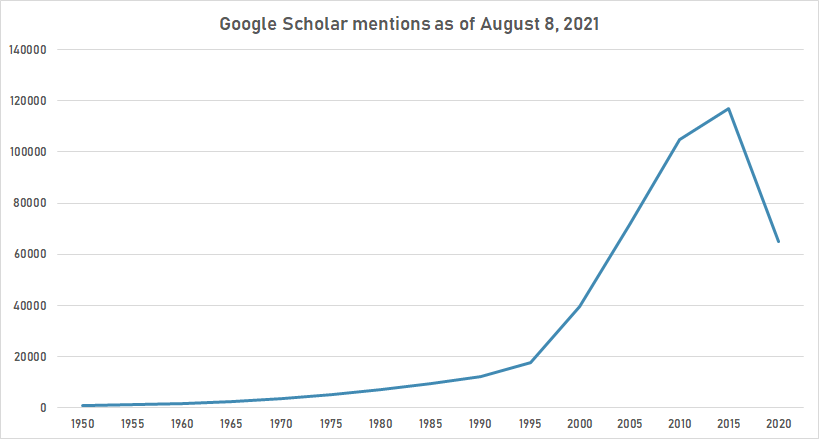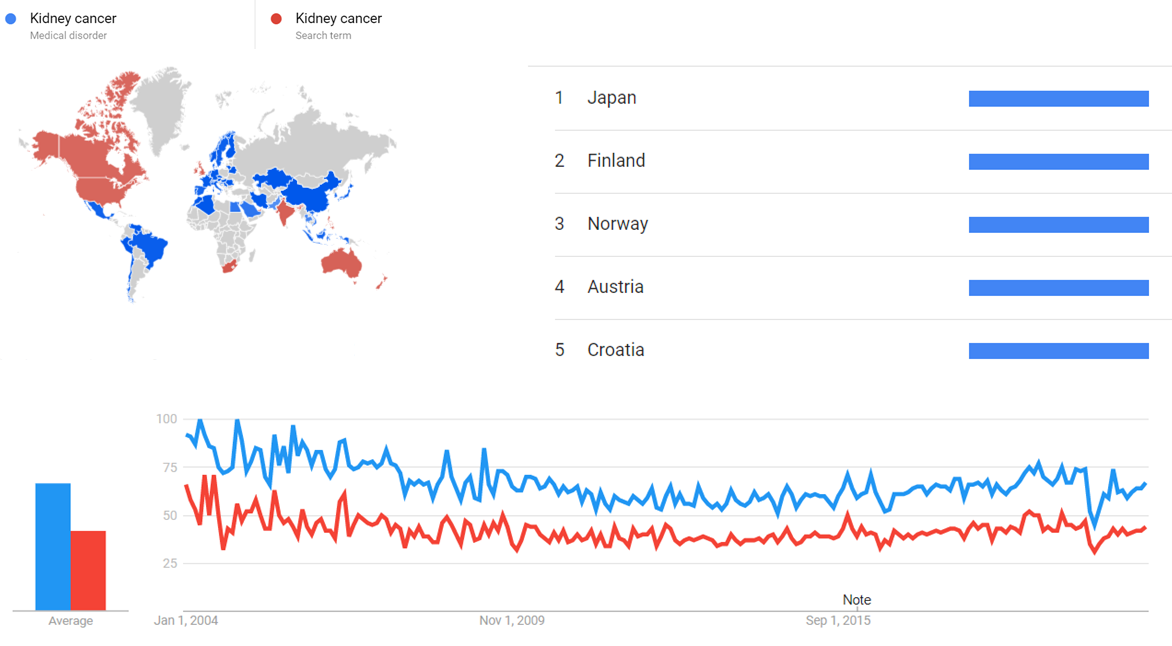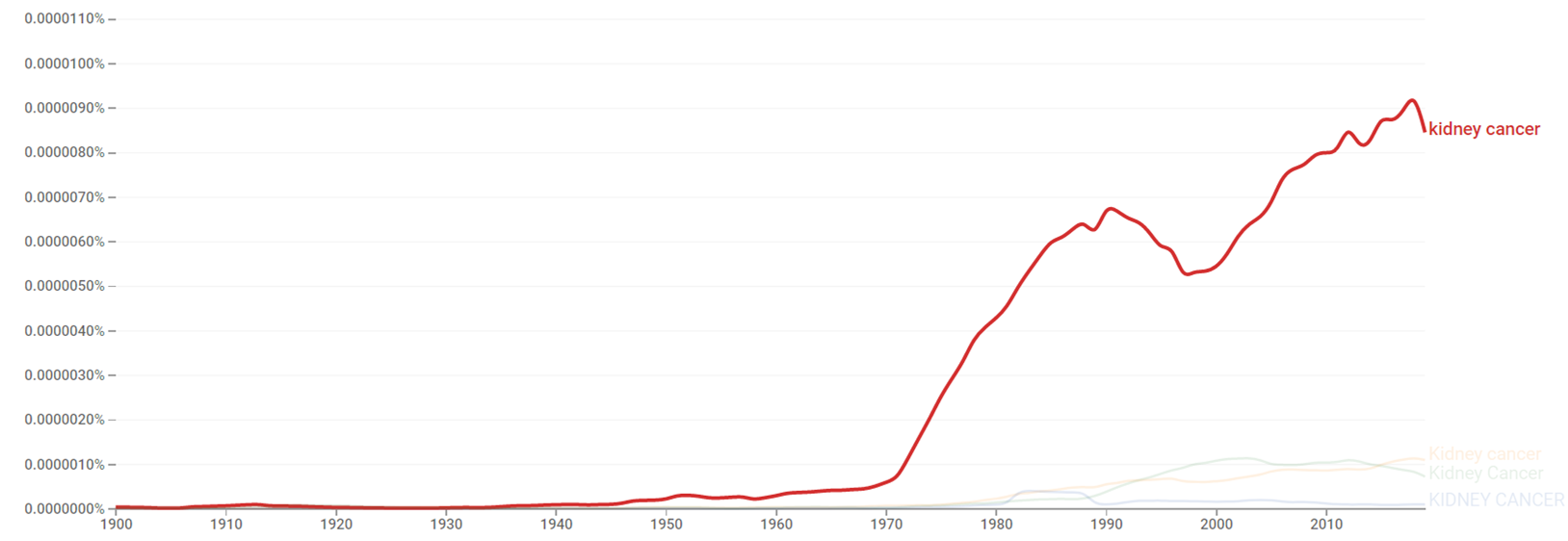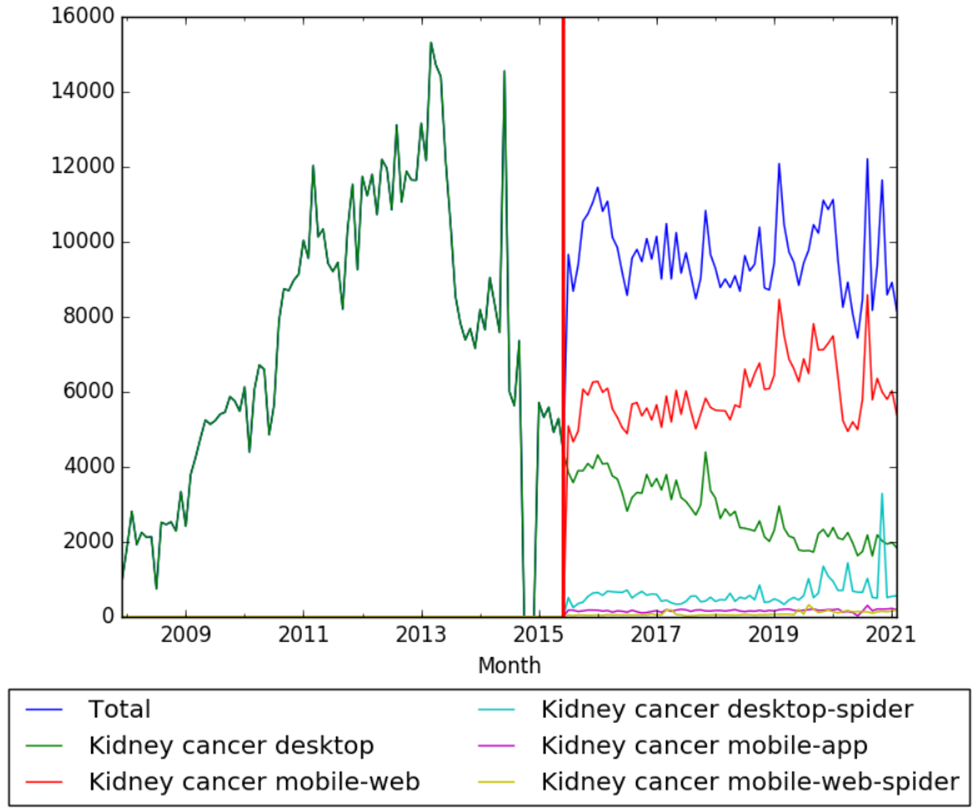Timeline of kidney cancer
This is a timeline of kidney cancer, describing especially major discoveries and advances in treatment of the disease.
Big picture
| Year/period | Key developments |
|---|---|
| 19th century | First descriptions of renal carcinoma are recorded. Nephrectomy is developed. |
| 20th century | More types of kidney cancers are described. Nephrology is established in the second half of the century. |
| Prior to 1980s | Very limited alternatives are available to treat kidney cancer. For patients whose cancer has not spread beyond the kidneys, complete surgical removal of the kidney is often, but not always, effective. For those with more advanced disease, however, the available chemotherapy and radiation treatments have little effect and survival is usually limited to a few months.[1] |
| 1980s onward | New imaging modalities such as ultrasonography, computed tomography, and magnetic resonance imaging come into widespread use. |
| 1990s | Immunotherapy is introduced, which enables doctors to extend the lives of some patients whose cancer have spread.[1] |
| Present time | Currently, most cases of kidney cancer occur in the developed world, with the highest incidence in North America and Europe, and the lowest incidence in Africa and Asia.[2] Treatments today include surgery, ablation, active surveillance, radiation therapy, targeted therapy, immunotherapy and chemotherapy.[3] |
Numerical and visual data
Google Scholar
The following table summarizes per-year mentions on Google Scholar as of August 8, 2021.
| Year | kidney cancer |
|---|---|
| 1950 | 805 |
| 1955 | 1,100 |
| 1960 | 1,700 |
| 1965 | 2,570 |
| 1970 | 3,530 |
| 1975 | 4,960 |
| 1980 | 7,170 |
| 1985 | 9,400 |
| 1990 | 12,300 |
| 1995 | 17,500 |
| 2000 | 39,500 |
| 2005 | 71,600 |
| 2010 | 105,000 |
| 2015 | 117,000 |
| 2020 | 65,100 |

Google Trends
The comparative chart below shows Google Trends data Kidney cancer (Medical disorder) and Kidney cancer (Search Term), from January 2004 to February 2021, when the screenshot was taken. Interest is also ranked by country and displayed on world map.[4]

Google Ngram Viewer
The chart below shows Google Ngram Viewer data for Kidney cancer, from 1900 to 2019.[5]

Wikipedia Views
The chart below shows pageviews of the English Wikipedia article Kidney cancer, on desktop from December 2007, and on mobile-web, desktop-spider, mobile-web-spider and mobile app, from July 2015; to February 2021.[6]

Full timeline
| Year/period | Type of event | Event | Location |
|---|---|---|---|
| 1613 | Development | German physician Daniel Sennert publishes his text Practicae Medicinae making the first reference suggesting a tumor arising in the kidney.[7] | |
| 1810 | Development | Case of renal carcinoma is first described.[8] | France |
| 1877 | Development | German surgeon Carl Langenbuch performs the first nephrectomy (kidney removal) for neoplastic disease.[9] | |
| 1899 | Development | German pathologist Max Wilms first describes nephroblastomas (kidney cancer in children), today also known as Wilms' tumors.[10] | |
| 1932 | Development | J. R. Hand and A. Broders first report a relationship between histological grade and cancer-specific survival in patients with renal cell carcinoma, showing that patients with high grade of RCC are more likely to die and die sooner after diagnosis than those with low grade tumors.[11] | |
| 1941 | Development | First description of hypercalcemia in renal cell carcinoma, separating into two categories: metastatic and nonmetastatic.[12] | |
| 1956 | Development | French physician Pierre Masson first describes tubulocystic renal cell carcinoma of the kidney.[13] | |
| 1957 | Treatment | Thalidomide is launched to the market as a immunomodulatory drug. Today it is used for treating some cancers, including kidney cancer.[14] | Germany |
| 1960 | Development | Nephrology, the discipline that studies the kidney and its functions, is established.[15] | |
| 1967 | Discovery | Juxtaglomerular cell tumor, a rare kidney tumor of the juxtaglomerular cells, is first described.[16] | |
| 1978 | Development | Researchers show that nephrectomy alone has a minimal effect on survival in patients with metastatic renal cell carcinoma.[17] | |
| 1978 | Discovery | Clear-cell sarcoma of the kidney is first described.[18] | |
| 1985 | Development | Researchers discover that immunotherapy with interleukin 2 leads to long term tumor shrinkage in some patients with metastatic renal cell carcinoma.[1] | |
| 1990 | Treatment | American physician Ralph Clayman performs the first laparoscopic radical nephrectomy (LRN) for a kidney tumor.[19] | |
| 1990 | Organization | The Kidney Cancer Association is founded. It provides patient information on the disease, its treatment, and clinical trials among other services.[20] | Evanston, Illinois, US |
| 1992 | Treatment | DFA approves interleukin 2, which soon becomes standard therapy for advanced renal cell carcinoma.[1] | United States |
| 1995 | Discovery | Renal medullary carcinoma (a rare type of cancer that affects the kidney) is first described.[21] | |
| 1995–1997 | Treatment | Cryoablation and radiofrequency ablation are introduced as alternatives to surgery into small renal tumors.[1] | |
| 2000 | Discovery | Researchers discover that combination of kidney removal and immunotherapy increases survival time by 50 percent in patients with advanced renal cancer.[1] | |
| 2000 | Organization | Kidney Cancer UK is founded as a charity to support "kidney cancer patients, their carers, medical professionals and scientific researchers."[22] | United Kingdom |
| 2001 | Development | The UCLA Integrated Staging System (UISS) prognostic model for renal cell carcinoma is developed.[23] | Los Angeles, California, US |
| 2004 | Treatment | First robot-assisted laparoscopic partial nephrectomy (ralpn) is introduced.[9] | |
| 2004 | Development | WHO introduces new classification of renal cell carcinoma, based on pathology and genetic abnormalities. Malignant tumors: clear cell renal cell carcinoma, multilocular clear cell renal cell carcinoma, papillary renal cell carcinoma, chromophobe renal cell carcinoma, carcinoma of the collecting ducts of Bellini, renal medulary carcinoma, xp11 translocation carcinomas, carcinoma associated with neuroblastoma, mucinous tubular and spindle cell carcinoma, and renal cell carcinoma unclassified.[7] | |
| 2005 | Treatment | FDA approves Nexavar (sorafenib) for treating advanced kidney cancer.[24] | United States |
| 2006 | Treatment | FDA approves Sutent (sunitinib malate) for kidney cancer patients because of its ability to reduce the size of tumors.[24] | United States |
| 2007 | Treatment | Intravenous drug temsirolimus (TEMSR) is approved for treating advanced renal cell carcinoma.[25] | |
| 2008 | Treatment | Oncophage is approved for use as a vaccine therapy against kidney cancer.[26] | Russia |
| 2009 | Treatment | FDA approves Votrient (pazopanib) as an oral medication that interferes with angiogenesis, the growth of new blood vessels needed for solid tumors to grow. It is a kinase inhibitor indicated for the treatment of patients with advanced renal cell carcinoma.[24][27] | United States |
| 2009 | Treatment | Bevacizumab is approved for treating metastatic renal cell carcinoma after multiple studies confirm benefit when combining with interferon.[1] | |
| 2009 | Treatment | FDA approves everolimus to treat metastatic kidney cancer that has progressed after treatment with either sorafenib or sunitinib.[28] | United States |
| 2012 | Report | With 338,000 new cases diagnosed, kidney cancer becomes the twelfth most common cancer in the world (joint position with pancreatic cancer).[2] | |
| 2012 | Treatment | FDA approved Inlyta (axitinib) as a prescription medicine used to treat advanced renal cell carcinoma when one prior drug treatment for this disease has not worked.[24] | United States |
See also
- Timeline of lung cancer
- Timeline of brain cancer
- Timeline of colorectal cancer
- Timeline of pancreatic cancer
- Timeline of liver cancer
- Timeline of bladder cancer
References
- ↑ 1.0 1.1 1.2 1.3 1.4 1.5 1.6 "Cancer progress". Retrieved 7 September 2016.
- ↑ 2.0 2.1 "Kidney cancer statistics". Retrieved 6 September 2016.
- ↑ "How is kidney cancer treated?". Retrieved 10 September 2016.
- ↑ "Kidney cancer". Google Trends. Retrieved 8 March 2021.
- ↑ "Kidney cancer". books.google.com. Retrieved 8 March 2021.
- ↑ "Kidney cancer". wikipediaviews.org. Retrieved 8 March 2021.
- ↑ 7.0 7.1 "Immunotherapy in Metastatic Renal Cell Carcinoma" (PDF).
- ↑ "Landmarks in the diagnosis and treatment of renal cell carcinoma". Retrieved 6 September 2016.
- ↑ 9.0 9.1 Lattouf, JB; Trinh, QD; Saad, F (2009). "The contemporary role of surgery in kidney cancer". Curr Oncol. 16 Suppl 1: S8 – S15. doi:10.3747/co.v16i0.410. PMC 2687804. PMID 19478900.
- ↑ "Wilms' tumours". Retrieved 6 September 2016.
- ↑ Nuñez, Kelvin R. Focus on Kidney Cancer Research. p. 101.
- ↑ Palapattu, GS; Kristo, B; Rajfer, J (2002). "Paraneoplastic Syndromes in Urologic Malignancy: The Many Faces of Renal Cell Carcinoma". Rev Urol. 4: 163–70. PMC 1475999. PMID 16985675.
- ↑ "Tubulocystic Renal Cell Carcinoma: A Rare Renal Tumor". Journal of Kidney Cancer and VHL. 1: 56. doi:10.15586/jkcvhl.2014.13.
- ↑ "History of Thalidomide". Retrieved 6 September 2016.
- ↑ Bickerstaff, Linda. Kidney Cancer: Current and Emerging Trends in Detection and Treatment.
- ↑ Naoto Kuroda; et al. (2011). "Review of juxtaglomerular cell tumor with focus on pathobiological aspect". Diagnostic Pathology. 6: 80. doi:10.1186/1746-1596-6-80. PMC 3173291. PMID 21871063.
{{cite journal}}: CS1 maint: unflagged free DOI (link) - ↑ Bhat, S (2010). "Role of surgery in advanced/metastatic renal cell carcinoma". Indian J Urol. 26: 167–76. doi:10.4103/0970-1591.65381. PMC 2938537. PMID 20877591.
{{cite journal}}: CS1 maint: unflagged free DOI (link) - ↑ SukdevJadhav, A; Jain, S; Tuteja, N; Agrawal, L (2014). "Clear Cell Sarcoma of Kidney in a Neonate". J Neonatal Surg. 3: 35. PMC 4420453. PMID 26023506.
- ↑ "Localized renal cell carcinoma management: an update". Retrieved 6 September 2016.
- ↑ "Kidney Cancer Resources". Retrieved 6 September 2016.
- ↑ Davis, Charles J.; Mostofi, F. K.; Sesterhenn, Isabell A. (1995). "Renal Medullary Carcinoma the Seventh Sickle Cell Nephropathy". The American Journal of Surgical Pathology. 19 (1): 1–11. doi:10.1097/00000478-199501000-00001. PMID 7528470.
- ↑ "Kidney Cancer UK". Retrieved 9 September 2016.
- ↑ "Kidney Cancer (Adult) - Renal Cell Carcinoma + - Text Size Download Printable Version [PDF]» Early Detection, Diagnosis, and Staging TOPICS Document Topics GO » SEE A LIST » Previous Topic How is kidney cancer diagnosed? Next Topic Survival rates for kidney cancer by stage How is kidney cancer staged?". Retrieved 6 September 2016.
- ↑ 24.0 24.1 24.2 24.3 "Therapies for Advanced Kidney Cancer". Retrieved 6 September 2016.
- ↑ Schrader, AJ; Seseke, S; Keil, C; Herrmann, E; Goebell, PJ; Weikert, S; Steffens, S; Bergmann, L; Roigas, J; Steiner, T. "Temsirolimus in daily use: results of a prospective multicentre noninterventional study of patients with metastatic kidney cancer". Eur Urol. 66: 275–81. doi:10.1016/j.eururo.2013.08.055. PMID 24012472.
- ↑ "Can we develop a vaccine for cancer?". Retrieved 6 September 2016.
- ↑ "Pazopanib shows better quality-of-life in advanced kidney cancer". Retrieved 6 September 2016.
- ↑ "Adjuvant Everolimus for Resected Kidney Cancer". Retrieved 6 September 2016.
Template:Cancer timeline Category:Kidney cancer Category:Health-related timelines